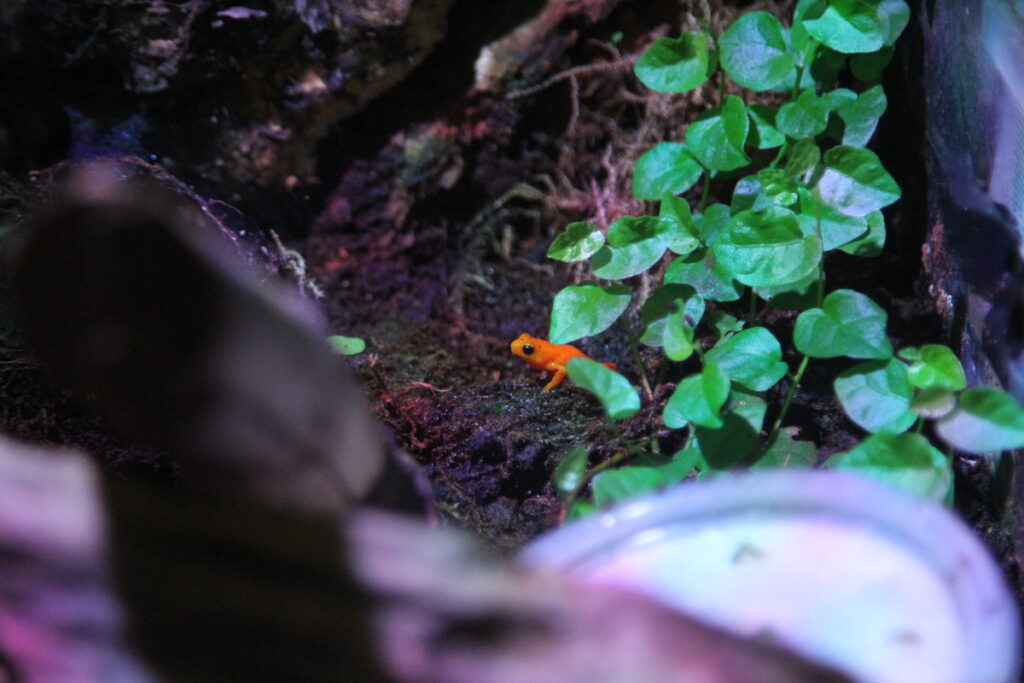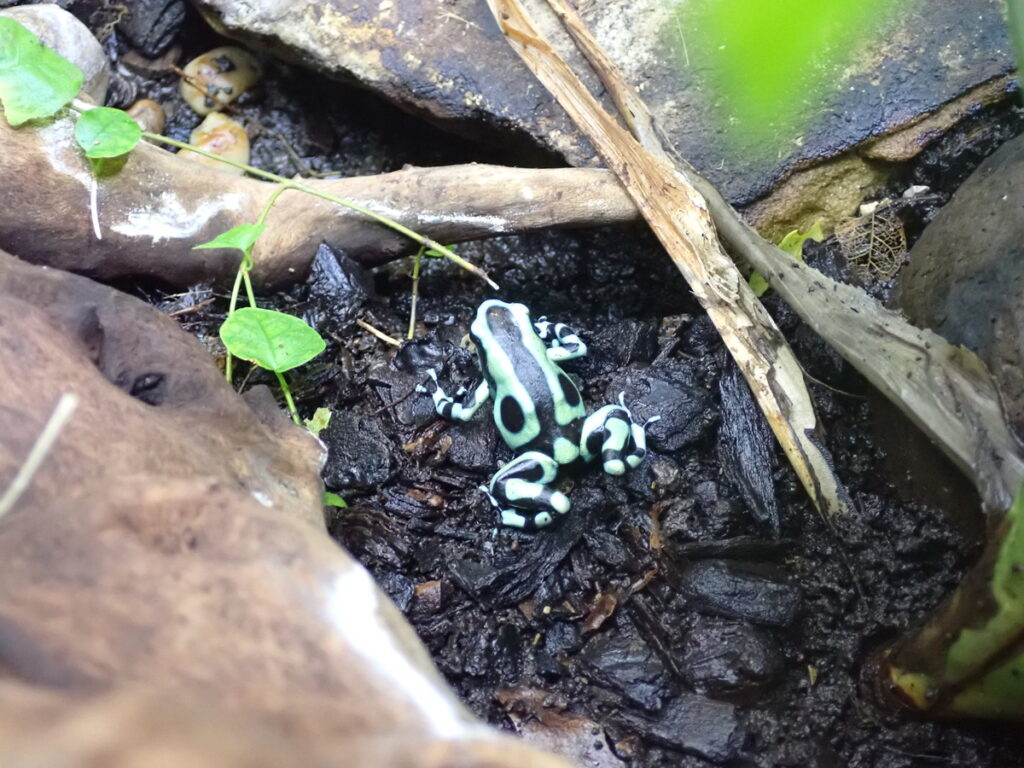Easy to overlook but always a fan favourite, frogs put on a majestic display thanks to their distinctive colouring, remarkable camouflage and sheer cuteness. Sure, they may not be top of many people’s list of animals to see here at Deep Sea World, but they promise to leave a lasting impression.
Previous visitors to DSW will know that we have something of a soft spot for these humble hoppers – we built a temple for them after all! So, with that in mind, today’s post is dedicated to our amphibian friends, as we take a look at 10 wonderful facts that you may not know about frogs.
1. There are over 7,500 species of frogs on (almost) every continent on Earth
They may be small, but frogs sure know how to travel. Millions of years of evolution have led to the creation of over 7,500 distinct frog species, spanning every continent on the planet with the exception of Antarctica. And the extraordinary thing is, scientists continue to discover more.

Did you know, also, that frogs account for around 86% of all of the world’s amphibians? That’s mightily impressive, particularly when you consider that toads, axolotls, salamanders, newts, and caecilians all fall into the same category.
2. Do frogs need to drink water? Not quite!
Frogs don’t guzzle down water like we do but, of course, being amphibians, they do rely on good old H2O to survive. So, how exactly do frogs get the water they need?
It’s easy – they absorb it! Frogs have unique permeable skin that water can simply travel through, giving them all the nutrients and minerals they need while helping them to stay nice and damp, just how they like it. That’s why you’ll almost always find frogs near water bodies like ponds and lakes, except in tropical rainforests, where the humidity alone is enough to keep frogs perfectly quenched.
3. Frogs demonstrate a range of emotions – just like humans!
With their slimy bodies, bulging eyes and distinctive colouring, frogs appear about as different from people as it’s possible to be. But despite these dissimilarities, it’s important to remember that they are sentient beings, capable of a complex range of emotions including happiness, anxiety, excitement, and stress.

We told you there was more to these hopping amphibians than meets the eye! And it gets more fascinating when you consider that frogs have been known to display altruistic behaviour – that’s when a creature puts the needs of another over their own. Adult frogs may, for instance, sacrifice themselves to protect their tadpole offspring.
4. Golden mantella frogs live in large groups with twice as many males as females
That makes for quite the mating season! Yes, these beautiful golden frogs live in strangely
lop-sided colonies, with males outnumbering females 2:1. They’re native to a very small tropical region on the African island of Madagascar, and are very similar in appearance to the poison dart frogs of South America – and no less toxic!
Sadly, golden mantella frogs are now considered critically endangered due to endemic habitat loss – that’s the final rung on the conservation ladder before an animal is considered extinct in the wild. Of course, in captivity, the fortunes of these rare amphibians are a little sunnier, and you can see the golden mantella for yourself at Deep Sea World.
5. The Borneo eared frog takes its name from its unusual appearance
One of the most distinctive members of the Temple of Frogs has to be the Borneo eared frog. These medium to large frogs can grow up to 10 cm in length and are named for the unique bony ridges that protrude out from their heads, giving them the appearance of having pointy, elf-like ears.
Like many frog species, the size and appearance of Borneo eared frogs differ by sex. Females, for instance, are significantly larger and bulkier with an average size of 6-8 centimetres, while the males are much slighter and only grow up to 6-8 centimetres on average.
6. Poison dart frogs are among the most poisonous amphibians in the world
With their eccentric colouring and contrasting patterns, there’s no denying that poison dart frogs are devilishly cute. But extreme caution is required where these teeny amphibians are concerned, with the poison dart frogs of South America being one of the most poisonous animals in the world.
Here at Deep Sea World, we host green and black poison dart frogs within our Temple of Frogs exhibit and have maximum respect for these beautiful, highly toxic creatures. These frogs have poisonous glands on the surface of their skin which, along with their markings, are used to deter would-be predators. Never has the term “look but don’t touch” been truer.
7. White’s tree frogs don’t need to live near water
White’s tree frogs buck the trend for amphibians needing to live near water. Spending much of their lives up trees in dry areas like those found in their native Australia, this unique species is able to survive in a seemingly inhospitable habitat thanks to a milky white coating found on its skin called “caerviein”, which essentially helps their skin to lock in moisture for longer.
That’s not to say that White’s tree frogs don’t need water altogether. But rather than skulking off to their nearest watering hole, these animals get all the water they need from the trees in which they live. Come say hello to these docile, lovable little fellas at Deep Sea World.
8. Some frog species can spend weeks, if not months, underwater
Get this: some frog species, particularly bullfrogs and green frogs, can spend weeks underwater at a time. When they’re submerged in water, frogs are able to breathe through their skin, which is what allows them to spend so much of their lives beneath the surface.
Most species of frogs don’t spend anywhere near that long in the water, with the average time being around 5-8 hours. Then, of course, you get tree frogs and toads, which rarely venture close to the water’s edge at all, particularly in the case of the White’s frog that we met earlier.
9. Goliath frogs are the largest frog species in the world
The evolution of frogs sure gave rise to some remarkable variations, with the goliath frog appearing like a different creature to its tiny, brightly coloured poison dart cousins. These frankly massive frogs can grow over 30cm long and weigh up to seven pounds – about the same as the average newborn human baby!
Due to their size, many people will be relieved to hear that you’re unlikely to stumble across a goliath frog at your local pond. These chunky amphibians are native to Cameroon and Equatorial Guinea where, due to human-caused habitat loss, they’re now considered endangered.
10. The UK has two native frog species, though several other species call our islands home
The UK has two predominant native frog species. These include the common frog, known for its unique “mask” on the back of its head, and the pool frog, which despite going extinct in the 1990s, is now flourishing amid the wetlands of Norfolk.
As well as these native species, a small handful of non-native frogs have also been seen in the UK. The most common of these is the marsh frog, whose unique croak is now a regular fixture on spring evenings across southeast England. Sightings of American bullfrogs have also been recorded, with these amphibians known for their powerful hops (over two metres in a single leap!).
Keen to learn more about our amphibious friends? Come on down to Deep Sea World and explore the curious creatures on display within the Temple of Frogs. Tap here for visitor information and to book your tickets
